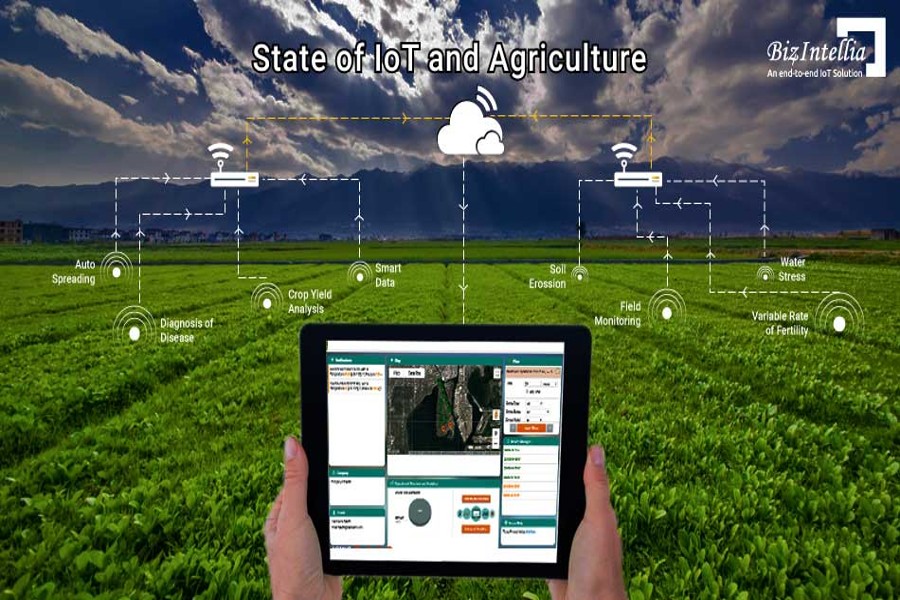IoT in Agriculture
Smart wearables, networked devices, automated machinery, and autonomous cars are all made possible by IoT technology. But the Internet of Things has had the biggest influence on agriculture. According to the most recent statistics, there will be 9.6 billion people on the planet by 2050. And the agriculture sector will undoubtedly use the Internet of Things to feed this huge population. The Internet of Things (IoT) is removing barriers such as extreme weather, changing the climate, and the impact on the environment while also assisting in meeting the demand for more food.
In the latter half of the 20th century, mechanical advancements like tractors and harvesters were introduced into agriculture operations worldwide. Furthermore, the agriculture sector is highly dependent on creative thinking due to the ever rising demand for food.
The cheaper and more efficient farming output can be attributed to the Industrial IoT. Over the coming years, agricultural operations will employ more intelligent solutions driven by the Internet of Things. Actually, a small number of recent reports indicate that the agriculture sector would witness a compound annual growth rate of 20% for IoT device installation. Furthermore, by 2024, there will be 225 million connected agricultural equipment, up from 13 million in 2014.
In rural or less developed areas, an IoT solutions provider and the business owners had encountered difficulties implementing their products because of a lack of consistent and dependable communication network infrastructure. However, a number of network providers are enabling it through the expansion of cellular networks and the introduction of satellite connectivity.
How IoT in Agriculture took its footprints?
Sensors were first used in agricultural activities a long time ago. However, the drawback of the conventional method of using sensor technology was that we were unable to obtain real-time data from the sensors. We were able to use the data that the sensors had previously logged into their associated memory. Now that Industrial IoT has arrived in agriculture, even more sophisticated sensors are being used. The sensors are now linked to the cloud by a satellite or cellular network. This enables us to access real-time sensor data, facilitating efficient decision-making.
Farmers are now able to check water tank levels in real-time, which improves irrigation efficiency thanks to IoT applications in the agriculture sector. The application of sensors to every stage of farming, including the amount of time and resources needed for a seed to develop into a fully-grown crop, has been made possible by the growth of IoT technology in agriculture operations. The second wave of the green revolution has emerged: the Internet of Things in Agriculture. By implementing IoT, farmers are gaining two advantages. By enhancing farmers’ decision-making with precise data, it has assisted farmers in lowering expenses and raising yields simultaneously.
Applicability of IoT in Agriculture
A modern and efficient method for conducting agriculture and producing food in a sustainable manner is called “smart farming.” It is an application of integrating cutting-edge technologies and networked devices into agriculture. The Internet of Things plays a vital role in smart farming, as it reduces the need for farmers and growers to do labor-intensive tasks by hand and boosts output in every way.
The Internet of Things has greatly benefited agricultural, especially with regard to efficient use of water and input optimization, among other benefits, given the current trends in agriculture. The significant advantages, which have recently changed agriculture, were what made a difference. Because IoT-based smart farming monitors the field in real time, it enhances the agriculture system as a whole. The Internet of Things in Agriculture has decreased the wasteful use of resources like water and electricity while also saving farmers time thanks to sensors and interconnectivity. It monitors a number of variables, including temperature, humidity, soil, and so on, and provides an incredibly clear real-time observation.
IoT-enabled agriculture has aided in the application of cutting-edge technical solutions to tried-and-true expertise. This has aided in closing the gap between amount yield, quality, and productivity. Fast action and reduced harm to the crops are ensured by data ingested through the acquisition and importation of information from the various sensors for use in real time or storage in a database. Produce is processed more quickly and arrives to supermarkets in the quickest amount of time thanks to flawless end-to-end intelligent operations and enhanced business process execution.
Featured Image
https://www.linkedin.com/pulse/iot-agriculture-revathi-ravichandran/
Source:

